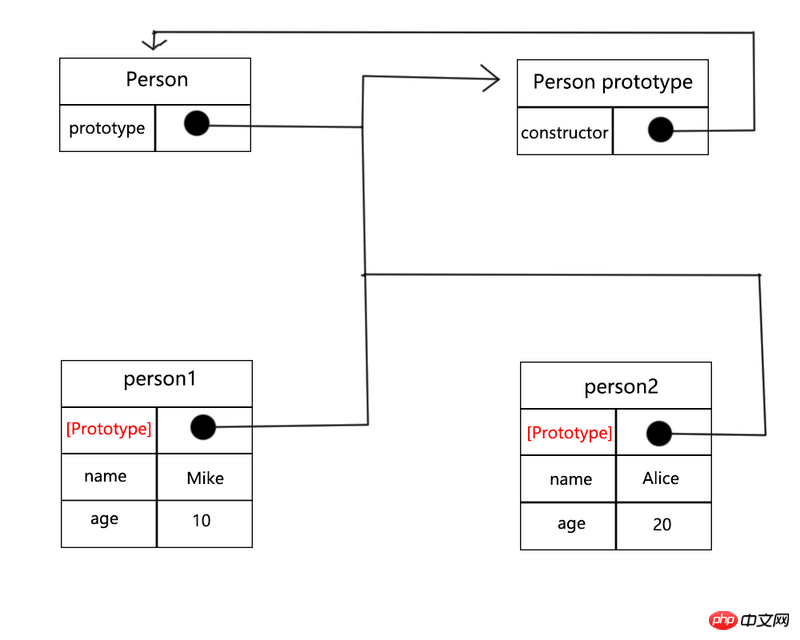最近在学vue,到周末终于有空写一些东西了(想想又能骗赞,就有点小激动!)。在javascript基础中,除了闭包之外,继承也是一个难点。因为考虑到篇幅较长,所以打算分成两个部分来写。同样基于《javascript高级程序设计》,做一个详细的讲解,如果有不对的地方欢迎指正。
为了更好的讲解继承,先把一些准备知识放在前面。
构造函数,是用来创建对象的函数,本质上也是函数。与其他函数的区别在于调用方式不同:
如果通过new操作符来调用的,就是构造函数
如果没有通过new操作符来调用的,就是普通函数
例子:
function Person(name, age) {
this.name = name;
this.age = age;
}
//当做构造函数调用
var person1 = new Person('Mike',10);
//当做普通函数调用,这里相当于给window对象添加了name和age属性,这个不是重点,只要注意调用方式
Person('Bob',12);
console.log(person1)//Person {name: "Mike", age: 10}
console.log(name)//Bob
console.log(age)//12在var person1 = new Person('Mike',10);中,通过new操作符调用了函数Person,并且生成了person1,
这里的Person就称为构造函数,person1称为Person函数对象的一个实例。实例中会有一个constructor属性,指向对应的构造函数,看下面的例子:
function Person(name, age) {
this.name = name;
this.age = age;
}
var person1 = new Person('Mike',10);
var person2 = new Person('Alice',20);
console.log(person1.constructor)//function Person(){省略内容...}
console.log(person2.constructor)//function Person(){省略内容...}当我们每次创建一个函数的时候,函数对象都会有一个prototype属性,这个属性是一个指针,指向它的原型对象。原型对象的本质也是一个对象。初次看这句话可能有点难以理解,举个例子,还是刚刚那个函数:
function Person(name, age) {
this.name = name;
this.age = age;
}
console.log(Person.prototype)//object{constructor:Person}可以看到Person.prototype指向了一个对象,即Person的原型对象,并且这个对象有一个constructor属性,又指向了Person函数对象。是不是有点晕?没关系,接下来我们就上比举例子更好的手段--画图。
在前面,我们刚刚介绍过了构造函数,实例和原型对象,接下来我们用一张图来表示这三者之间的关系(用ps画这种图真是麻烦的要死,大家有好的工具推荐一下):
从图上我们可以看到:
函数对象的prototype指向原型对象,原型对象的constructor指向函数对象
实例对象的new4属性指向原型对象,这里的new4是内部属性,可以先理解为它是存在的,但是不允许我们访问(虽然在有些浏览器是允许访问这个属性的,但是我们先这样理解),这个属性的作用是:允许实例通过该属性访问原型对象中的属性和方法。比如说:
function Person(name, age) {
this.name = name;
this.age = age;
}
//在原型对象中添加属性或者方法
Person.prototype.sex = '男';
var person1 = new Person('Mike',10);
var person2 = new Person('Alice',20);
//只给person2设置性别
person2.sex = '女';
console.log(person1.sex)//'男'
console.log(person2.sex)//'女'这里我们没有给person1实例设置new7属性,但是因为new4的存在,会访问原型对象中对应的属性;
同时我们给person2设置new7属性后输出的是'女',说明只有当实例本身不存在对应的属性或方法时,才会去找原型对象上的对应属性或方法
在js中,继承的主要思路就是利用原型链,因此如果理解了原型链,继承问题就理解了一半。在这里可以稍微休息一下,如果对前面的准备知识已经理解差不多了,就开始讲原型链了。
原型链的原理是:让一个引用类型继承另一个引用类型的属性和方法。
先回顾一下刚刚讲过的知识:
原型对象通过constructor属性指向构造函数
实例通过var person1 = new Person('Mike',10);1属性指向原型对象
那现在我们来思考一个问题:如果让原型对象等于另一个构造函数的实例会怎么样?
例如:
function A() {
}
//在A的原型上绑定sayA()方法
A.prototype.sayA = function(){
console.log("from A")
}
function B(){
}
//让B的原型对象指向A的一个实例
B.prototype = new A();
//在B的原型上绑定sayB()方法
B.prototype.sayB = function(){
console.log("from B")
}
//生成一个B的实例
var a1 = new A();
var b1 = new B();
//b1可以调用sayB和sayA
b1.sayB();//'from B'
b1.sayA();//'from A'为了方便理解刚刚发生了什么,我们再上一张图:
现在结合图片来看代码:
首先,我们创建了A和B两个函数对象,同时也就生成了它们的原型对象
接着,我们给A的原型对象添加了var person1 = new Person('Mike',10);2方法
* 然后是关键性的一步var person1 = new Person('Mike',10);3,我们让函数对象B的var person1 = new Person('Mike',10);4指针指向了一个A的实例,请注意我的描述:是让函数对象B的var person1 = new Person('Mike',10);4指针指向了一个A的实例,这也是为什么最后,B的原型对象里面不再有constructor属性,其实B本来有一个真正的原型对象,原本可以通过B.prototype访问,但是我们现在改写了这个指针,使它指向了另一个对象,所以B真正的原型对象现在没法被访问了,取而代之的这个新的原型对象是A的一个实例,自然就没有constructor属性了
接下来我们给这个B.prototype指向的对象,增加一个var person1 = new Person('Mike',10);7方法
然后,我们生成了一个实例b1
最后我们调用了b1的sayB方法,可以执行,为什么?
因为b1有var person1 = new Person('Mike',10);1属性可以访问B prototype里面的方法;
我们调用了b1的sayA方法,可以执行,为什么?
因为b1沿着var person1 = new Person('Mike',10);1属性可以访问B prototype,B prototype继续沿着var person1 = new Person('Mike',10);1属性访问A prototype,最终在A.prototype上找到了sayA()方法,所以可以执行
所以,现在的结果就相当于,b1继承了A的属性和方法,这种由var person1 = new Person('Mike',10);1不断把实例和原型对象联系起来的结构就是原型链。也是js中,继承主要的实现方式。
原文来自于https://segmentfault.com/a/1190000007376061
以上就是详细解读js中的继承机制的详细内容,更多请关注php中文网其它相关文章!

每个人都需要一台速度更快、更稳定的 PC。随着时间的推移,垃圾文件、旧注册表数据和不必要的后台进程会占用资源并降低性能。幸运的是,许多工具可以让 Windows 保持平稳运行。

Copyright 2014-2025 //m.sbmmt.com/ All Rights Reserved | php.cn | 湘ICP备2023035733号